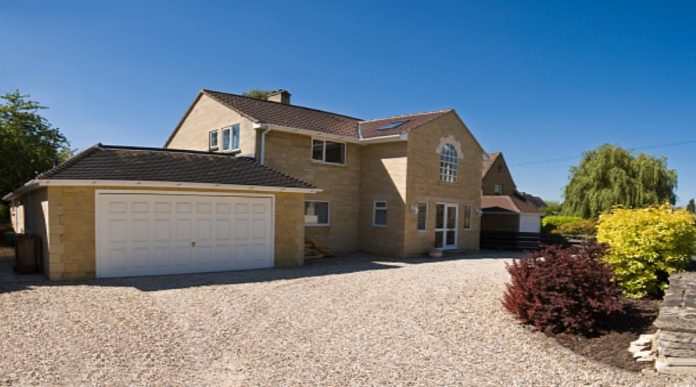Homeowners in the United Kingdom have a certain preference for gravel driveways, and for a good reason. Gravel driveways are easy to maintain, economical, and look beautiful, often bringing out the beauty of your exterior landscape. Gravel can be obtained in a variety of options and colours, enabling you to have a modern or rustic feel. While a gravel driveway is relatively easy to install, you have to construct it in the right way to minimise future maintenance.
While the average cost of creating a gravel driveway is about £69 per m2 if you want to build from scratch, an overlay can cost at least £30 per m2. However, you must also consider the maintenance costs of the driveway if you want it to last longer. You must take care of the washed-out places, vegetation control, grading, and compacting the driveway every three to five years. Additionally, the driveway might need a fresh top layer every five to ten years due to general tear, wear, ploughing, and washout.
Before constructing a gravel driveway, remove the existing soil and form a bed within a foot depth. You need to add stones of different sizes when creating layers of materials, and then add 2-4 inches of gravel before you can start with the driveway construction. We recommend adding a French drain to ensure the driveway has a perfect drainage system, especially in places having water log issues.
Comparing Quotes Could Save You Upto 33%:
How Much Does a Gravel Driveway Cost?*
Creating a gravel driveway often leaves many homeowners wondering how much it would cost to make and maintain them. The cost of constructing a gravel driveway also depends on your region in the UK, the contractor’s labour fee, and the type of gravel. We will discuss the factors that increase the cost of building a driveway in a later section.
It can be a little tricky calculating an estimate of what these projects would cost, especially if you aren’t used to estimating large-scale projects. We have created a cost calculator table to help you find an estimate for your driveway.
| SIZE | TIME(ESTIMATED) | MATERIAL COST | LABOUR FEE | TOTAL ESTIMATED COST |
| Small driveway(20m2) | 1 to 2-days | £1150 | £500 | £1650 |
| Medium driveway(40m2) | 2 to 2.5-days | £2100 | £650 | £2750 |
| Large driveway(80m2) | 2.5 to 3-days | £3050 | £810 | £3860 |
| Overlay gravel (40m2) | 1-day | £850 | £340 | £1190 |
*The figures in the table do not show the true cost but are estimates of what to expect. The estimation can help you get started on planning and budgeting your driveway. Costs in London and Southeast England can be up to 15-20% higher than elsewhere.
Comparing Quotes Could Save You Upto 33%:
Factors Affecting Gravel Driveway Cost
Remember that the estimated cost of your gravel drive may increase due to some factors. Some factors that can affect what you spend on building a gravel driveway are:
Size
The driveway size is perhaps the most important factor in determining your spending. You may have to go for a larger driveway if you have two or more cars. In addition, you have to consider the distance of your house to the road, and if you have a front garden or trees you don’t want disturbing — this will result in extra costs due to additional diversion, increasing the size.
You should check with a driveway contractor from companies like Bark to learn about your driveway’s local requirements.
Depth of Foundation
The foundation depth of a driveway depends on the area’s underlying geology. You need a solid foundation for a stable and well-built driveway. Meanwhile, you must take out the topsoil before constructing from bedrock or subsoil. You can only know the topsoil depth after you have dug the soil, and the process might cost you around £79/m3.
Waste removal
If you have an existing driveway, you have to remove it before you can excavate the soil for your foundation. The cost of waste removal could cost you around £50/week. Heavy clay and topsoil may cost difficulty in drainage or cause an unstable drive. Thus, you must remove them before you build your driveway.
Weed mat
You may need geotextiles if you don’t want weeds growing on your driveway or the gravel’s surface mixing with your foundations. A geotextile membrane or a weed mat costs around £41/m2.
Hardcore thickness
As mentioned before, the soil conditions decide the foundation excavation depth you need for your driveway. So, you also have to consider the hardcore thickness in constructing your driveway. You can spend between £34 to £65/tonne on hardcore. However, since the amount of hardcore that can fit one cubic metre can be challenging to calculate (due to the gap between rocks), use this guide for help.
- Cost of crushed concrete hardcore = £150/m3.
- Cost of MOT Type 1 aggregate = £150/m3.
Comparing Quotes Could Save You Upto 33%:
Site conditions
You should check the site conditions of your driveway, as you may spend more if you have a sloped terrain than a level drive. In addition, wet and low terrains require drain tile installation and extra filling. It will cost you more to buy hardcore and gravel if you have terrain issues or a sloppy drive. Hence, you should ensure that you level your driveway as even as possible.
Renting equipment
Renting equipment like a compactor, skid loader, backhoe, or excavator can exponentially increase the cost of your driveway. You may spend at least £150 and more when you hire equipment. However, you can also do this work with a pickaxe and shovel to save on equipment renting costs.
Hiring a plant compactor to fill the cavities and support the hardcore with a solid base can cost you around £31/day.
Edging
When constructing a gravel driveway, you must consider the material of the perimeter edge that ensures that the gravel does not creep into the lawn or flowerbeds. The best borders include kerbstones, bricks, or concrete edge blocks. Be sure to pick the right edge block that can fit your driveway and suits your design needs.
Drainage
The driveway’s drainage should be among the most important factors you should consider when estimating the cost. Fortunately, a gravel driveway offers you a cost-effective parking space because it has a porous compacted hardcore. Hence, an additional drainage system isn’t usually needed as the water naturally drains away.
On the contrary, if you have a steep gradient in your driveway, you may experience water rushing off before drainage. People in areas which experience frequent heavy rains and waterlogging issues should consider adding an additional drainage system. Sometimes, even the driveway’s length determines if you have to add an extra drainage route.
Gravel type
Due to the wide variety of gravel types, you should consider the rock, colour, and sizes before constructing your driveway. Please note that different rock types and colours may garnish different costs. We recommend checking your local stores for more affordable gravels suiting your style needs.
Other factors
The time of year determines how much you can pay for a driveway. During winter, you don’t spend much to hire excavation contractors. You can enjoy lower bids when you want to construct a driveway. If you have to remove stumps or trees, you will pay more to the contractor.
Comparing Quotes Could Save You Upto 33%:
Driveway Options
To construct your driveway, you should consider many broken rocks and gravel types. Each material you use has properties, benefits, pros, and cons. As a result, you should know why you need the material for your drive. Remember that you pay more when purchasing smaller quantities than large amounts. We recommend builder merchants or DIY stores for purchasing smaller quantities; however, buying a large volume is much safer shall you need more than the estimated figure, touching up or serving as an emergency supply.
MOT Type 1
You can buy MOT Type 1 under different names on the market. You use this material to create a compact, stable, but porous base. To create a great foundation, you need the 40mm aggregate, while the 25mm aggregate can serve as your uppermost layer of gravel. MOT Type 1 cost around £61 for 800kg bags on the market.
Pea Shingle
You can buy pea shingle as pea grit or pea gravel, and it contains stones with varying diameters starting from 10mm to 20mm. Pea shingle comes smooth in appearance but may not lock together. Therefore, you require the help of a perimeter edge.
Some of the colours you can consider include red, grey, brown, blue, yellow, or white. You should budget around £80 for 950kg bags; the price varies according to location and seller.
Crushed Marble Chips
You will see crushed marble ships in varying colours when building your driveway. However, most homeowners prefer the pure white called dolomite or white spar. You can ask your constructor to help you make the right choice when selecting diameters. Since the marble comes slippery and smooth, the chips come creepy. Hence, the chips require edging to help them stay contained.
Marble chips cost around £195 per 900kg because they offer premium appearances.
Crushed Stone
The crushed stone comes as a mix of coarse sand and crushed stone and is ideal as hardcore. Additionally, you can use it as a top layer or raw material for your concrete. Crushed stone can compact excellently and works as an all-purpose aggregator for your landscaping cleveland oh and drainage. Crushed stone costs at least £75 for a 900kg bag.
Washed Stone
Many people confuse the washed stone with the crushed stone because they look similar. However, washed stones come with fractions or sand washed away. You can find it useful as your top layer and foundation material, and you can buy it for as much as £75 for a 900kg bag.
Blue Grey Slate Chips
The blue-grey slate chips offer a great alternative if you don’t want to use the standard gravel. You can use the chips as flower bed mulch, driveway covering, and a garden path. The colours fit your environment and compliment the different building materials used on your driveway.
Meanwhile, don’t expect to buy the blue-grey slate chips cheap because they are more expensive than the other stones. However, homeowners who live in a place with slate quarries can buy them at an affordable rate. If you buy from builders merchants or garden centres, you can spend at least £10 per 25kg bag.
Stone Screenings
The stone screenings or stone dust appears like the standard coarse sand. You can use the stone with other small stones or alone.
Some other uses of screenings include:
- You can use stone screenings to create an impermeable surface compacted or on its own.
- With the stone, you can create a binding layer when you combine it with larger stones into an aggregate.
- The stone can mix with cement or asphalt to construct a road surface or a path.
Stone screenings can cost at least £72 per 860kg bag.
River polished pebbles
The river polished pebbles found on shingle beaches or a river bed come as polished stones. The stones have various colours and help water drainage with the best surface. While the river polished pebbles appear great with porous surfaces, don’t expect to experience a good surface on your driveway.
You can use the pebbles to ensure your driveway border becomes more stable. Lastly, you can purchase about £300 per 850kg bag for polished river pebbles.
Comparing Quotes Could Save You Upto 33%:
Tips for Gravel Driveway Installation
The first step of creating a gravel driveway begins when you pick the suitable gravel. However, gravel may not complete your driveway, so you need other things to construct your driveway.
Here are some of the tips that have helped many homeowners in the United Kingdom to build their driveways.
Drainage
A driveway requires a drainage system if it must enjoy a long-lasting and stable surface. Thus, you have to create the right drainage system.
Firstly, you may discover that the small stones and sand can become submerged and function separately and loose. When this happens, the blown soil is a horrible material mix on the driveway surface. Thus, the water drainage suffers blockage.
According to planning regulations, artificial surfaces and poor drainage can lead to urban flooding. As a result, the SUDs rules ensure that driveways offer extra drainage or stay porous to push water to soakaways.
Edging
Borders and edging can help homeowners keep their driveways neat. For instance, many gravel types come rounded and smooth without interlock. Thus, the stones can move when people drive or walk across them. If you don’t handle this situation, you will find gravel on public roads, flowerbeds, and lawns.
Site preparation
You have to make sure that the excavated site has correctly prepared foundations before you can add the surface layer. You must also remove all topsoil and adequately compact the foundation layers.
Remember to avoid tree roots and weeds from coming up your driveway. Hence, you must
- Ensure that you excavate to the proper depth.
- Compact the hardcore and ensure that it does not have any movement.
- Fill cavities and holes by properly placing the blinding aggregate layer and keep the layer compacted.
- Add a geotextile member below your surface layer and foundation top to avoid mixing and growth of weeds.
Choose a professional
While using a DIY gravel driveway, you should consider a professional grade operator from brands like Bark if you want an excellent job. A professional understands how to excavate and the right raw materials required for the foundations. Also, with the help of a professional, you can have the ideal surface layers and solid foundations without wasting raw materials. Remember that using experienced professionals equals money saved on subsequent driveway maintenance.
Comparing Quotes Could Save You Upto 33%:
Why Lay a Gravel Driveway?
You need a gravel driveway if you own a car and want a perfect space. With such a driveway, you offer an eco-friendly and sustainable method of producing a solid car standing.
Additionally, a gravel driveway improves a property’s value. However, UK homeowners should know a few things about using gravel for their driveway.
- Homeowners who want affordable driveways consider gravel surfaces over other driveways. Gravel driveways are also suitable for homeowners with long driveways.
- You don’t have to become a professional before you can lay gravel or need any tools. You can construct your driveway with DIY online or instructions from construction books. However, with the support of a professional, you can have a perfectly crafted driveway with minimal wastage and pristine standards.
- Constructing a gravel driveway is the easiest and quickest out of all other types of driveways. Constructing and installation take less than a week.
- With a gravel surface, you can easily maintain your driveway. Filling in sunken areas can be done with a rake, a shovel, and a bag of gravel.
- Unlike concrete or tarmac, a gravel driveway is ready to use as soon as it is installed.
- Because of its porous nature, you don’t suffer from poor drainage and, therefore, save on not having to add additional drainage systems. Additionally, gravel is an eco-friendly product and allows replenishment of groundwater.
- With its various textures and colours, you customise how your driveway looks. Gravel driveways can also give your home a distinct appearance.
- If you have a well-built driveway, the value of your property increases.
How Long Does It Take?
Laying a gravel driveway works best when you hire a contractor for the job. However, a DIY project can still garner a good driveway without difficulty. Construction and settling down of the gravel usually takes less than a week, and homeowners can start using it as soon as it is installed.
Steps involved in creating a new gravel driveway for your home:
Mark the boundaries
To mark your driveway’s perimeter, you need metal stakes, a ball of string, or wood stakes.
Remove topsoil
You need to remove the topsoil and vegetation from your enclosed region. You can achieve this in the following ways:
- You can use a pickaxe and a shovel to handle this task.
- Hire a professional excavator if you cannot do the job alone.
- Lastly, you can hire an operator and an excavator.
Calculate the foundation’s volume
You need a bit of mathematics when creating your driveway. When you get to the subsoil, you should calculate your excavation’s volume. Therefore, you can multiply your excavation length by its width if you want to get the area calculation.
For instance, a driveway measuring 4 x3m has 12m2 for its total area. Remember that the gravel top layer has to measure 50mm in thickness, while the sub-base foundation should measure about 125mm.
You must measure the excavation depth from its surrounding level and down to the excavation base. As a result, you need to deduct 50mm before you can get the foundation’s top level.
Meanwhile, you should excavate more if your proposed foundation depth does not reach 12mm. However, you don’t have to dig again if the depth is at least 125mm.
The next thing to do is to multiply the area by the foundation depth to get the foundation volume. So, the calculation goes this way; 125mm or 0.125m can be multiplied by12 to give us 1.5m3.
You should ensure compaction works by adding 4% to your foundation volume 1.5×1.04 = 1.56m3.
With this calculation, you can estimate the MOT Type 1 or a crushed stone has the calculated volume.
Calculate gravel volume
You must multiply 50mm (0.05m) by the area (12m2) if you want to know the top layer’s volume. 12×0.05 = 0.6m3.
Remember to add the volume to the 4%: 0.6×1.04 = 0.84m3.
Order and lay the foundations
You should ensure that you carry this action well, which has to shovel the hardcore straight to the ground for a solid and stable base. You must ensure that the shovelling continues until the extra layers reach the proper thickness. In addition, you have to compact to develop a smooth surface on your driveway.
Comparing Quotes Could Save You Upto 33%:
Geotextile membrane
You have to lay geotextile the membrane on the compacted foundation’s top. A simple way to handle this process requires tucking the geotextile membrane into the surrounding corners.
Lay edging stones
Around the driveway’s perimeter, you should add a bed of mortar, including kerbstones, into the bed. With the help of the kerbs, the geotextile can stay in position.
Lay the top layer of gravel
Ensure that when you lay the top gravel, it does not exceed 50mm thick. If the gravel exceeds 50mm, you may have it difficult to drive or walk on it.
With a rake, you can evenly spread the gravel layer and ensure that mounds and hollows don’t appear on the surface. You need to allow the gravel layer to settle before you use it. Furthermore, you would continue adding gravel and stop when it gets to the kerbstones’ top.
Trim the weed membrane
You should ensure that you keep the gravel driveway tidy always. You should topple the gravel up and bring back swept or washed away gravel.
What’s the job’s duration?
The gravel driveway construction could take at least two to three days if you hire a mechanical excavator. However, this duration does not include the time used to order your stones.
Day one activities: Excavating the foundations, laying hardcore, and blinding with sands.
Day two to three activities: Laying geotextile membrane, bedding kerbstones, and gravel.
The United Kingdom Planning Permission
You don’t need planning permission in the United Kingdom to build a driveway. However, you must comply with the following rules:
- You must ensure that you create a permeable surface. With gravel, you can achieve this type of surface.
- Ensure you divert the surface rainwater to a soakaway, lawn, or flowerbed.
The Sustainable Urban Drainage System (SUDS) regulations help to minimise urban flooding or surface water run offs with the support of natural ground drainage.
Meanwhile, you must get permission from the relevant authority if you want to install any dropped kerb. The building of your driveway must not affect the accessibility of your home. As a result, follow the UK Building Regulations in creating your driveway.
Wrapping Up!
A gravel driveway is the simplest and most affordable driveway homeowners can get. Gravel driveways have numerous design options, look beautiful, and are DIY-friendly. Many first-time house owners may find the task daunting, and thus, this guide serves as a one-stop solution for all their planning and budgeting problems while also keeping them informed in the process of building their gravel driveway.
However, please ensure that you consider all the factors, including maintenance costs, before building a gravel driveway. Good luck and happy construction!
Comparing Quotes Could Save You Upto 33%:
Disclaimer: This article contains sponsored marketing content. It is intended for promotional purposes and should not be considered as an endorsement or recommendation by our website. Readers are encouraged to conduct their own research and exercise their own judgment before making any decisions based on the information provided in this article.


































